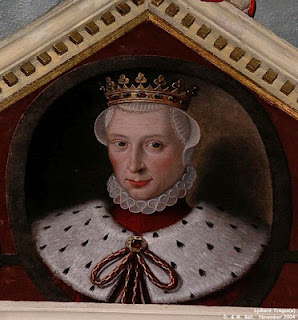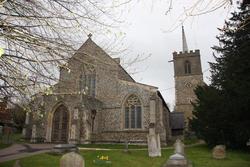William Carey, who married into the Boleyn family, had a family which wasn't short on its own scandal. The Carey family were descended from Edmund Beaufort, and therefore were cousins to King Henry VIII, through his grandmother Margaret Beaufort.
Thomas Carey and Margaret Spencer (1472-1536) had seven children;
+ William Carey (1495-1528) m. Mary Boleyn
+ John Carey (1491-1552) m. Joyce Denny
+ Edward Carey (1498-1560)
+ Eleanor Carey (1499-1528)
+ Anne Carey (1493-1550)
+ Mary Carey (1501-60) m. John de Laval
+ Margaret Carey (1496-1560)
Eleanor and Anne Carey both became Benedictine nuns at Wilton Abbey. Wilton Abbey had gained a reputation for housing scandalous nuns who had had affairs with men and even born children.
On the 24th April 1528 the Abbess of Wilton Abbey, Cecily Willoughby, died and a new Abbess needed to be appointed.
Cardinal Thomas Wolsey, who was at this time high in the king's favour, chose as candidate for the position Isabel Jourdain as she was "ancient, wise and discreet" and he hoped she would have a good influence on the nuns there. Isabella Jourdain was the sister of Agnes, the Abbess of Syon Abbey. In 1528 Isabella was the Prioress at Wilton Abbey. The nuns had delegated Cardinal Wolsey to elect the new Abbess and he concluded that Isabella should be Abbess and Eleanor Carey should be the new Prioress. The nuns who objected to this appointment were imprisoned under the orders of Cardinal Wolsey and it was by doing this that he got the convent to accept his choices.
However, Anne Boleyn became involved in the matter and put forward Eleanor Carey for the position. This probably came about due to suggestions from William and John Carey and Mary Boleyn to Anne that she ask the king for this. This was the last royal favour that William Carey sought out as he died in the June of that year. On the 23rd June 1528 Thomas Heanage wrote a letter to Wolsey about the Abbess situation;
“Mr Carey begs you to be gracious to his sister, a nun at Wilton Abbey …”
However by the time Wolsey received this letter, William Carey had died of the sweating sickness.
King Henry decided to look into the matter and choose between the two candidates by having Cardinal Wolsey interview the two women to reveal any impediments to them becoming Abbess.
However, this examination of Eleanor by Cardinal Wolsey soon revealed things which quite abruptly put an end to her aspirations of being made abbess. Henry wrote to Anne of what had been confessed by Eleanor;
Once it was clear that Eleanor was unfit for the position of Abbess, her elder sister Anne Carey who was also a nun at Wilton was put forward for the position. The Carey family pointed out that Isabella was not fit for the position either, they claimed she had led an unchaste life in her younger years and had two illegitimate children, and was now 'spotted with incontinence'.
King Henry refused to give the position to either Carey girls nor Isabella Jourdain. However, Cardinal Wolsey went ahead and gave the Abbess position to Isabella. By doing this Wolsey was showing a disregard for the king's wishes in terms of the spiritual life in England and therefore challenging the king's authority. This event was the first major dispute between the King and Wolsey, and was the beginning of the breakdown of their relationship and eventually, Wolsey's downfall.
Thomas Carey and Margaret Spencer (1472-1536) had seven children;
+ William Carey (1495-1528) m. Mary Boleyn
+ John Carey (1491-1552) m. Joyce Denny
+ Edward Carey (1498-1560)
+ Eleanor Carey (1499-1528)
+ Anne Carey (1493-1550)
+ Mary Carey (1501-60) m. John de Laval
+ Margaret Carey (1496-1560)
On the 24th April 1528 the Abbess of Wilton Abbey, Cecily Willoughby, died and a new Abbess needed to be appointed.
| Wilton Abbey |
| William Carey |
“Mr Carey begs you to be gracious to his sister, a nun at Wilton Abbey …”
However by the time Wolsey received this letter, William Carey had died of the sweating sickness.
King Henry decided to look into the matter and choose between the two candidates by having Cardinal Wolsey interview the two women to reveal any impediments to them becoming Abbess.
However, this examination of Eleanor by Cardinal Wolsey soon revealed things which quite abruptly put an end to her aspirations of being made abbess. Henry wrote to Anne of what had been confessed by Eleanor;
'As touching the matter of Wilton, my lord cardinal has had the nuns before him and examined them, Master Bell being present, who has certified to me that for a truth she has confessed herself to have had two children by sundry priests, and further since has been kept by a servant of Lord Broke that was, and not long ago; wherefore I would not for all the world clog your conscience nor mine to make her ruler of a house who is of such ungodly demeanour, nor I trust, you would not that neither for brother nor sister I should so stain mine honour and conscience. And as touching the prioress or Dame Eleanor's eldest sister though there is not any evident cause proved against them, and that the prioress is so old that of many years she could not be as she was named: yet notwithstanding to do you pleasure I have done that neither of them shall have it, but some other good and well disposed woman shall have it, whereby the house shall be the better reformed and God much the better served.'
Once it was clear that Eleanor was unfit for the position of Abbess, her elder sister Anne Carey who was also a nun at Wilton was put forward for the position. The Carey family pointed out that Isabella was not fit for the position either, they claimed she had led an unchaste life in her younger years and had two illegitimate children, and was now 'spotted with incontinence'.
King Henry refused to give the position to either Carey girls nor Isabella Jourdain. However, Cardinal Wolsey went ahead and gave the Abbess position to Isabella. By doing this Wolsey was showing a disregard for the king's wishes in terms of the spiritual life in England and therefore challenging the king's authority. This event was the first major dispute between the King and Wolsey, and was the beginning of the breakdown of their relationship and eventually, Wolsey's downfall.



